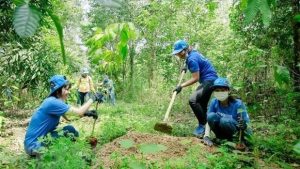
In early July, the Parliament engaged in a significant and widely-discussed issue regarding the use of forest land for the construction of the North-South expressway in seven provinces across the East, including Ha Tinh, Quang Binh, Quang Tri, Quang Ngai, Binh Dinh, Phu Yen, and Khanh Hoa. This issue was not centered around inflation or gasoline prices, but rather on changing the purpose of 1,054 hectares of forest land. During the meeting, 100% of the National Assembly Standing Committee members agreed on the policy of changing the use purpose of forests, forest land, and wet rice land from two crops or more. Out of the 1,054 hectares proposed for conversion, there are 111.84 hectares of protection forest, 4.45 hectares of special-use forest, 802.91 hectares of production forest, and 135.43 hectares of non-planning forest. In addition, the area also includes 14.89 hectares of protection forest, 0.22 hectares of special-use forest, and 120.32 hectares of production forest. The total forest land area is 1,863.94 hectares, including 138.10 hectares of protection forest land, 4.61 hectares of special-use forest land, and 1,721.23 hectares of production forest land.
The main objective is to strike a balance between economic development, trade, and social improvement while also adhering to the government’s forest development policy and protecting the environment and livelihoods. This development project is not a trade-off or forest sacrifice but rather one that takes into account all aspects and is optimally calculated. The conversion has minimal impact on the environment while ensuring the progress of this national key project.
According to Mr. Bui Chinh Nghia, Deputy Director of the General Department of Forestry, Ministry of Agriculture and Rural Development, in order to convert one hectare of planted forest, one hectare of replacement forest must be planted, while converting one hectare of natural forest requires three hectares of replacement forest. The required tree species for afforestation must comply with the provisions of Circular 13 of the Ministry of Agriculture and Rural Development. The People’s Committee of the province where the project is located will have two options: to find the land fund and plant it according to the acreage, or if they are unable to do so, the investor will have to find it. If the land fund cannot be found, the investor will have to pay that amount to the locality, and the locality will report to the Ministry of Agriculture to choose another locality to plant instead.
Many have concerns about the converted forest area, but the assessment shows that, aside from the natural forest area with a reserve of 36m3 of wood/ha, the planted forest area mainly consists of acacia and eucalyptus with low economic value. The North-South Expressway Project is crucial for the country’s socio-economic development, and while “touching” the forest is inevitable, maximum effort will be made to minimize the impact on the environment, nature, workers’ livelihoods, ecosystems, and to ensure that the forest is not used for any other purposes.

